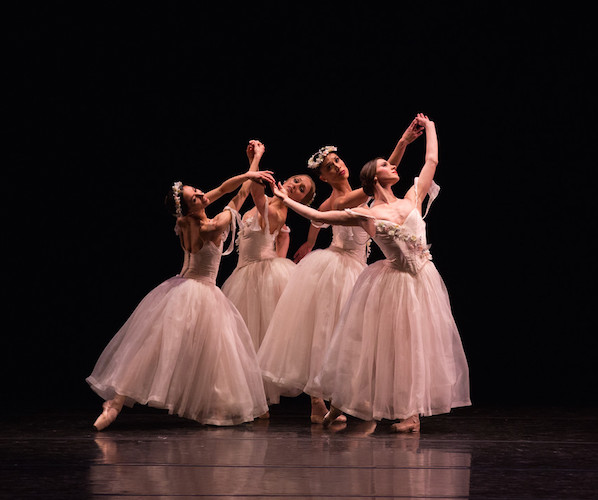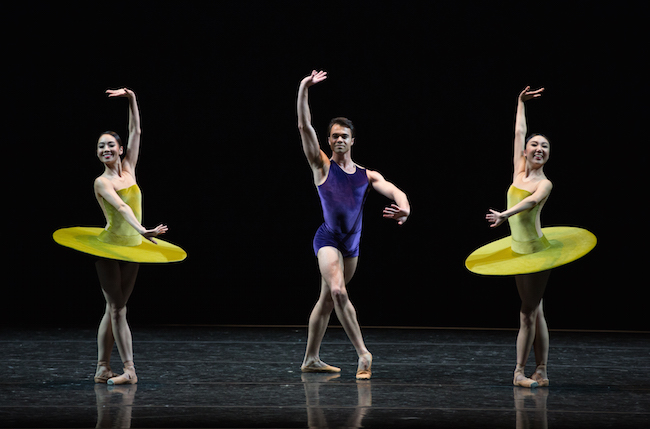Dance Review: Style Survey — “Kaleidoscope” at Boston Ballet
I’d seen all of these works on the Boston Ballet’s program once or twice in the past. They all seemed to improve with these additional viewings.
Kaleidoscope, performed by the Boston Ballet at the Opera House, Boston, MA, through March 26.

Boston Ballet performing Leonid Yakobson’s “Pas de Quatre.” Photo: Rosalie O’Connor, courtesy of Boston Ballet.
By Marcia B. Siegel
Boston Ballet’s Kaleidoscope program covered the gamut of 20th century styles in one evening. Beginning with George Balanchine’s neo-classical Kammermusik No. 2 (1978), the survey encompassed Leonid Yakobson’s retrospective romanticism (Pas de Quatre, 1971), William Forsythe’s tilted take on ballet modernism (The Vertiginous Thrill of Exactitude, 1996), and finally Léonide Massine’s comic look at café life (Gaîté Parisienne, 1938). I’d seen all of these once or twice in the past — many times for the perennial Gaîté, which American Ballet Theater used to keep around as a dependable crowd-pleaser. They all seemed to improve with these additional viewings.
Kammermusik No. 2 is one of Balanchine’s essays on a musical score, in this case Paul Hindemith’s 1924 work of the same name for piano and strings. With a corps of eight men and two male-female couples, the dance makes visible the dualities of the score. Most of the time the music was playing in two keys at once, or two rhythms at once; the tempos varied almost without warning. Its overlaps and disconnects provided Balanchine with the opportunity to allow the two groups of dancers to work in counterpoint, and to develop varying moods. Although it’s entirely formal, the dance/music takes us from excited footwork to slow, introspective plastique.
Balanchine pulled off an innovation: substituting a male corps de ballet for the traditional female ensemble. As a backdrop for the solo couples, they often pose with effete, crooked wrists and otherwise kinky bodies. On their own they form stage-filling, shifting geometric pattens with linked hands and stretched lunges. The body movement for this group has roots in the early 20th century. It echoes the modernistic angles and mechanistic pistons of Balanchine’s constructivist predecessors in Soviet Russia, especially Kasian Goleizovsky. When Balanchine emigrated to Europe in 1924 and joined the Diaghilev Ballets Russes, his Prodigal Son (1928) had a male corps of libertines who lurched and stomped with upturned arms and flexed feet. These grotesque shapes got transposed to the men in Kammermusik, without the malevolent overtones.
Kammermusik isn’t as thrilling as Balanchine’s other Hindemith ballet, the great Four Temperaments (1946), which has also been in the Boston Ballet repertory. The later work doesn’t focus as strongly on solo dancing, which humanizes the formal design of both ballets. But Thursday night’s cast in Boston gave a good account of the choreography, especially Lia Cirio, who infused certain phrases with her own musicality.
I thought Cirio’s big presence was less effective in the Pas de Quatre, which is a reworking of the celebrated showpiece for four famous ballerinas of the 19th century. Yakobson substituted excerpts from Bellini’s melodramatic opera Norma for the Pas de Quatre‘s original score by Cesare Pugni. Yakobson more or less discarded Jules Perrot’s choreography as it’s traditionally done, except for the linked poses that the women return to between individual variations. These girlish clusters Yacobson put in motion, as the four dancers (Cirio, Maria Baranova, Ashley Ellis and Erica Cornejo) glided across the stage in a close sisterly formation, turning and dipping without unclasping their hands. This made a fascinating contrast to the arms-length repositionings of Kammermusik‘s men.

Seo Hye Han, Paulo Arrais, and Ji Young Chae performing in Boston Ballet’s production of William Forsythe’s “The Vertiginous Thrill of Exactitude.” Photo: Rosalie O’Connor, courtesy of Boston Ballet.
Forsythe’s Vertiginous Thrill came 13 years after the death of Balanchine, when the dance world was longing for a successor but half-hoping one wouldn’t materialize. It seemed for a while that Forsythe might be the one, until his cranky originality took him away from ballet and into the esoteric realms of dance-theater. Vertiginous, however, reveals Forsythe’s grip on the classical idiom and its conceits.
The dance for five soloists (Misa Kuranaga, Seo Hye Han, Ji Young Chae, Paulo Arrais and John Lam) is entirely formal, entirely classical. What makes it modern is Forsythe’s way of breaking the classical rules. He pushes the equilibrium off balance, crams many more steps than customary into a phrase. As if to test the whole technical apparatus, he keeps the arms in motion almost all the time, changing positions too fast to look graceful.
The women are in lime green tutus with stiff, platelike skirts, and the men wear purple satin briefs with purple tops and faux-naked backs. To complete the irony, Forsythe chose the fourth movement of Franz Schubert’s Ninth Symphony, one of the mainstays of the classical music repertory, and, without exactly ignoring it, respected its propulsive and genial sensibility.

A scene from Boston Ballet’s production of Léonide Massine’s “Gaîté Parisienne.” Photo: Rosalie O’Connor, courtesy of Boston Ballet.
Gaîté Parisienne is a latter-day story ballet. In place of doomed princes, fairies, and magic spells, there’s a café populated by waiters and maids, soldiers, aristocrats, and eccentric hangers-on, who mingle with each other regardless of class. There’s a comic Peruvian Dandy (Federico Fresi) who shows off and attracts a coterie of dancing girls. All the men pursue a Glove Seller (Anaïs Chalendard), and eventually they all fight over her before she chooses the Baron (Eris Nezha) for the night. The music segues into Offenbach’s Barcarole and all the troops pair off and steal away, the men propelling their partners with the swinging arms of gondoliers.
Massine’s café is a frenetic place, full of waltzes, cakewalks, raucous can-can dancing, and around the edges a constant blur of activity — people pouring Champagne, squabbling over their bill, negotiating with the vendors of gloves, flowers, ice cream. At one point I was distracted by two women jabbing billiard cues into the wings where, presumably, there was a game going on.
Massine choreographed Gaîté for the Ballet Russe de Monte Carlo, one of many successors to the Diaghilev Ballets Russes, and it became a box-office breadwinner for the company with the beloved stars Alexandra Danilova and Frederic Franklin as the principal lovers. After the ’40s, American Ballet Theater kept it in repertory. The production was replaced in 1988 by an array of gaudy and expensive costumes by the celebrity couturier Christian Lacroix.
The Boston premiere, staged by the choreographer’s son, Lorca Massine, seemed slightly toned down from the riot of fussy design I remember from ABT, although it’s presumably the same Lacroix production Boston borrowed from that company. What with the poufy petticoats and extravagant miming, it struck the audience’s old-fashioned funny bone. Frivolous was good, then and now.
Internationally known writer, lecturer, and teacher Marcia B. Siegel covered dance for 16 years at The Boston Phoenix. She is a contributing editor for The Hudson Review. The fourth collection of Siegel’s reviews and essays, Mirrors and Scrims—The Life and Afterlife of Ballet, won the 2010 Selma Jeanne Cohen prize from the American Society for Aesthetics. Her other books include studies of Twyla Tharp, Doris Humphrey, and American choreography. From 1983 to 1996, Siegel was a member of the resident faculty of the Department of Performance Studies, Tisch School of the Arts, New York University.
Tagged: Boston-Ballet, Gaîté Parisienne, Kaleidoscope, Kammermusik No. 2, Marcia B. Siegel, Pas de Quatre
